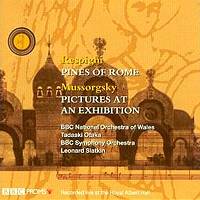
Aesthetic and didactic
Music by Respighi and Mussorgsky -
reviewed by
GEORGE BALCOMBE'Tadaaki Otaka conjures the composer's unique sound ...'
|

|
These two suites are widely divergent except that both are descriptive,
Respighi's Pines of Rome illustrates four sites in Rome and Mussorgsky's
Pictures at an Exhibition re-exhibits ten sketches and paintings by his
recently-dead friend Viktor Hartmann. One of these, The Great Gate of Kiev,
is illustrated in the booklet accompanying the disc. Mussorgsky separates
his pictures with five Promenades. The disc is a recording taken from two
live concerts, at London's Royal Albert Hall, during the BBC Proms Season of
2004.
The structure of Respighi's music is skilful, subtle and obscures neither
the flow of melodies nor the sensuous orchestration. Tadaaki Otaka conjures
the composer's unique sound powerfully and sensitively from the BBC
National Orchestra of Wales. Gossamer strands of pianissimo float in
the air, yet, the Roman army's relentless crescendo in section 4, as they march
along the Appian Way, rises from nano to mega decibels at its fearful end
[listen -- track 4, 3:15-4:37].
The Pines of Rome, far from being four wish-you-were-here musical
picture postcards, is in fact a profound meditation on mankind's existence
and, prophetically, eventual non-existence. The music is the evidence of
Respighi's adoption of the tradition by which a work of art can be not only
aesthetic but also didactic.
Allegorical art clearly attracted Respighi and in 1928 he composed an
orchestral trilogy, motivated by three of Botticelli's paintings -- La Primavera,
L'adorazione del Magi and La Nascita di Venere. As was
then common practice among Italian painters in the 1400s,
Botticelli's paintings, for example, also combined the didactic with the aesthetic.
So Respighi continued this Italian tradition, explicitly in the
Trittico Botticelliana; implicitly in the 1924 Pines of Rome.
Continue >>
Copyright © 23 October 2005
George Balcombe, London UK

|

